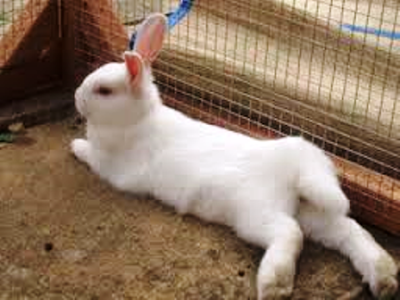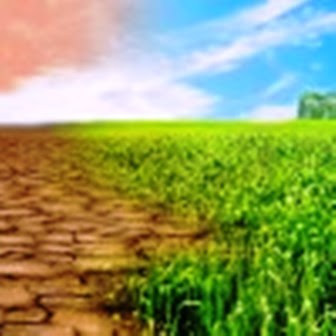CLIMATE AND RABBIT NUTRITION
Biometeorology is the study of the relationship between the environment and living organisms.
In homoeothermic animals, the goal is to maintain a stable body core temperature under most conditions.
In homoeothermic animals, the goal is to maintain a stable body core temperature under most conditions.
Environment affect nutrition:
Ambient temperature and humidity are the variables that most affect nutrition. Both directly influence the energy equilibrium of the animal, changing the flow of heat between the animal and the environment.
Definition of thermal neutrality:
The range of ambient temperature as an expression of thermal environment within which metabolic rate are at minimum and temperature regulation is achieved by non-evaporative physical process alone.
 |
| How rabbits control body temperature |
Rabbits take on a ball posture at <10 area="" conduction="" decrease="" for="" loss.="" or="" p="" radiation="" surface="" their="" to="">
The spread posture at 30°C allows more sensible heat to be dissipated.
The Ears:
The ears are a means of dissipating heat. Their heat exchange coefficient about four times the coefficient for the whole animal.
In a wind of 60 m/s, fully dilated ears can lose twice as much heat as ears in non-forced convection.
Most rabbits die after a few days? exposure to 40°C.
Related article: How extreme temperature is affecting rabbit production in Nigeria
Heat stress affects health and nutrition:
Exposure to high ambient temperatures induces rabbits to try to balance the excessive heat load by using different heat dissipation pathways. If such means are not sufficient then physiological traits deteriorate, including depression in feed intake, efficiency and utilization, disturbances in water, protein, energy and mineral metabolism balances, enzymatic reactions, hormonal secretions and blood metabolites.
Thermal stress directly affects reproduction, health and nutrition, and all of these interact with each other. The overall result for animals exposed to thermal stress is always a reduction in productivity, which varies according to the severity of the stress and the acclimatization of the animal.
Depressed feed intake and increased water consumption are the most important reactions to heat exposure. At 30°C rabbits consume only 60-70% of the feed intake recorded at 20°C. In contrast, water requirement increase by 50% as the temperature rises from 18°C to 28°C.
Blood metabolites such as glucose, serum total protein, serum total lipid and cholesterol decrease, which may be correlated to the decrease in energy metabolism during heat exposure.
Nutritional value of feedstuffs:
In tropical countries, the nutritive value of forages is relatively low, with high indigestible fibre.
Forage alone cannot support high performance in either growth or lactation. Supplementation of pelleted diets with potential energy sources, including roots, tubers, fruits and grain by-products, has generally demonstrated that 50-70% of pellets can be replaced by green forages, by-products or roots without a significant reduction in growth performance.
Related article: Nutritional value of rabbit feed stuffs
Nutrient allowances in different environment:
The adverse effect of temperature on efficiency and production should be minimized by adjusting nutrient levels. Assuming that maintenance needs for protein are not influenced by thermal stress, the protein/energy ratio is increased during both cold and heat stress, resulting in excess protein being used an energy source. The practical approach in cold conditions is to increase dietary energy levels.
The consequences of hot environments on feed intake, which means less protein being ingested and reduced growth, have generally resulted in recommending higher levels of protein in warm climates.
The addition of some amino acids, particularly lysine, has alleviated the effect of heat.
High-energy diets have been reported to overcome the lower energy intake in hot environments.
Increased voluntary intake in cold conditions tends to overcome any marginal deficiency in nutrients, although not in energy.
A smaller proportion of dietary protein is needed, and more protein is utilized as an additional energy source.
A high-fat diet has been shown to be most effective means of maintaining body temperature.
The addition of probiotics in hot climates and/or adding disodium or dipotassium carbonate has proved to be effective at high temperature.
The water to food intake ratio of about 2 has been recorded for adult rabbits fed ad libitum at 20°C.
There is a rise in the ratio of water intake to DM intake up to 2.4 between 20°C and 30°C.
Drinking cool water has sometimes been recommended in hot situations.
Effect of heat stress on breeding does:
High ambient temperature appears to act on reproduction both directly and through the depression of voluntary feed intake. Does kept at 35°C die within 72h.
One action would seem to increase the DE of diets with more cereals or by adding fat.
Although under normal conditions does compensate for different diet density through corresponding changes in feed intake. Some added fat elicits a better response from does, perhaps related to high milk-fat output.
Low-energy diets gave a poorer response at 30°C constant temperature, while no statistical
difference was found between the high-energy diets.
Effect of heat stress on males
High ambient temperatures have adverse effects in bucks, potentially producing temporary sterility, decreasing libido, delaying age at first mating and reducing semen quality and quantity.
The effects of heat stress may be due to a decrease in testosterone concentration and spermatogenesis and become more pronounced when relative humidity is high. High-energy diet alleviates the negative effects of high temperature.
Zinc supplementation has been found to reduce the depression of semen production.
Related article: Effect of heat stress on male rabbits
Effect of heat stress on growing rabbits:
Voluntary feed intake varies according to weather conditions are cold or warm. A reduction in intake occurs at 22-25°C, and certainly impaired growth is assured around 30°C.
A reduction of 25% in feed intake, comparable with the percentage observed in hot climates, should be balanced by about the same increment of dietary nutrients. Both increasing DE by some 10% and increasing protein and lysine, found no improvement in average daily weight gain in rabbits kept at 30°C.
When comparing low- and high-fat diets, while gains at moderate temperatures of 12°C and 18°C were similar, at 24°C, 30°C and 33°C the use of high-fat diets slightly improved growth performance.
Related:


